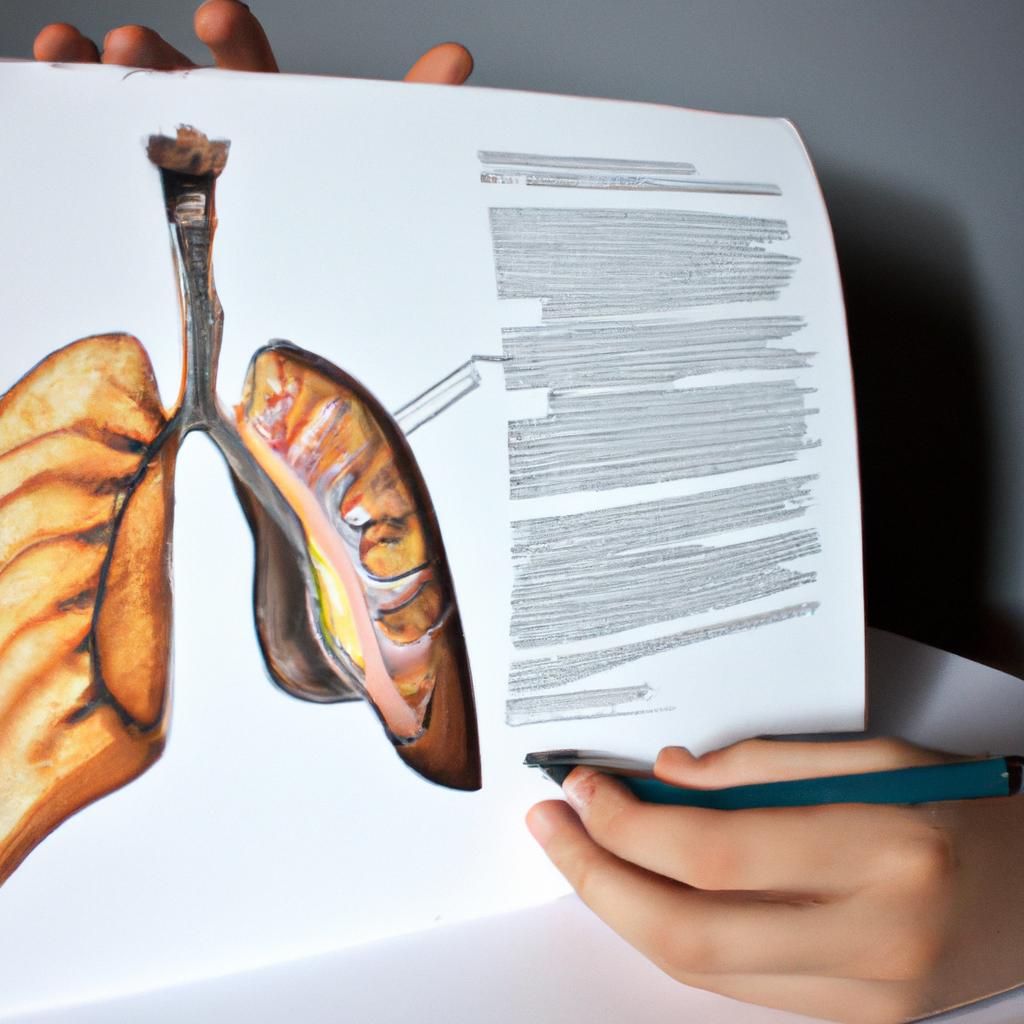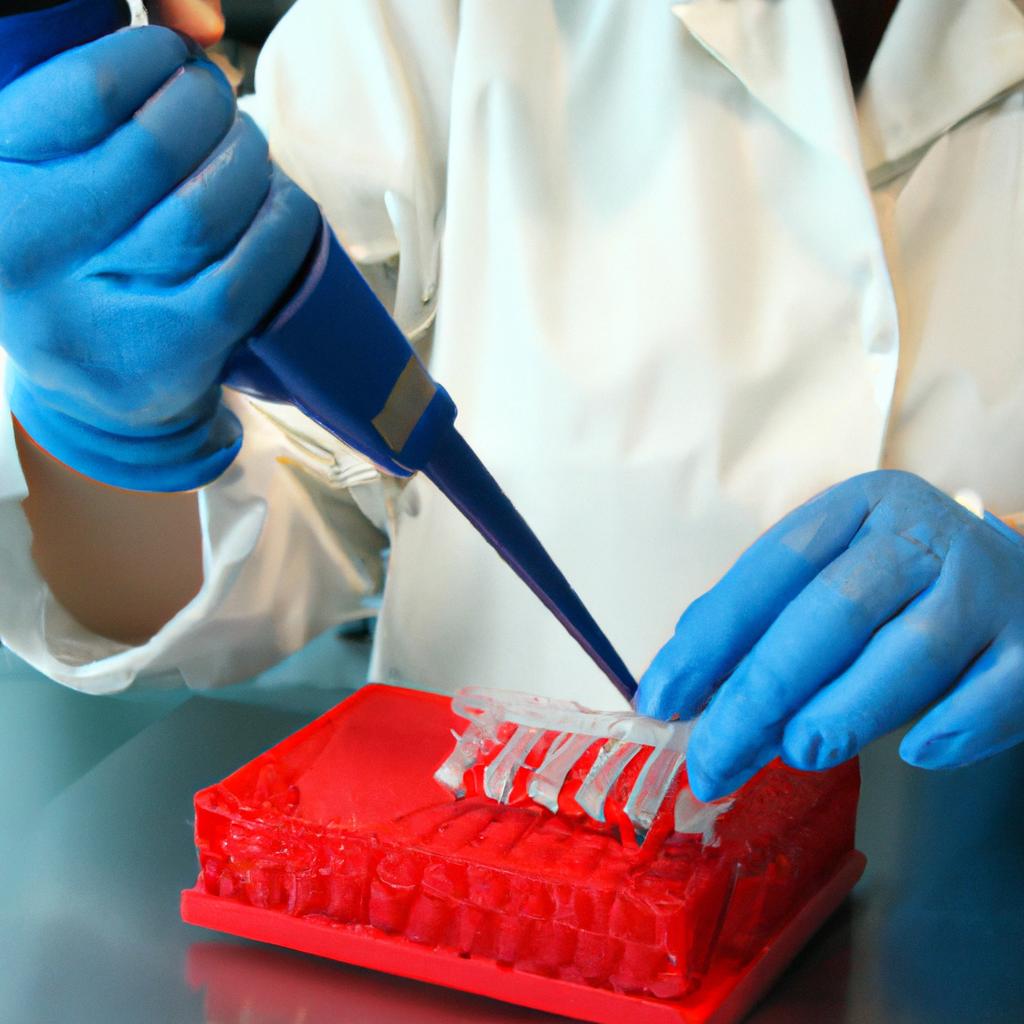The Anatomy of the Skeletal System: A Comprehensive Exploration in Biology

The human skeletal system serves as the structural foundation of our bodies, providing support, protection, and mobility. Understanding its intricate anatomy is crucial for comprehending various biological processes and disorders. In this comprehensive exploration into the anatomy of the skeletal system, we will delve into its composition, organization, and functions to gain a deeper appreciation for this complex yet essential component of human biology.
Imagine a scenario where an individual experiences difficulty in walking due to persistent pain in their lower back. By examining the underlying structure of the skeletal system, we can identify potential causes such as misalignment or degeneration of vertebrae within the spine. This case study exemplifies how knowledge about the intricacies of the skeletal system enables us to comprehend and address issues affecting its functionality. From bones that form rigid frameworks to joints that facilitate movement, each element plays a vital role in maintaining overall bodily integrity. Therefore, through this article, we aim to unravel the mysteries surrounding the anatomy of the skeletal system and shed light on its indispensable contributions to human life and well-being.
Skeletal System: Definition and Function
The skeletal system, composed of bones, cartilage, ligaments, and tendons, serves as the structural framework for the human body. Its primary function is to provide support, protection, movement, storage of minerals, and production of blood cells through a process known as hematopoiesis. To understand the significance of this complex system in maintaining bodily functions, let us consider an example.
Imagine a professional ballet dancer executing graceful movements on stage. As she performs intricate pirouettes and grand jetés, her skeletal system provides the necessary support and stability required for such remarkable feats. Without this internal framework working harmoniously with muscles and joints, her ability to glide effortlessly across the floor would be compromised.
To further appreciate the impact of the skeletal system on our daily lives, we can examine its essential characteristics:
- Strength: The bones are resilient structures that enable humans to withstand external forces without fracturing easily.
- Flexibility: Cartilage acts as a cushion between bones at articulating surfaces while allowing for effortless joint movement.
- Adaptability: Bones have impressive regenerative capabilities. They can grow or remodel themselves according to changes in physical demands or injuries.
- Vitality: Bone tissue plays a crucial role in regulating calcium levels within the bloodstream. It also houses bone marrow responsible for producing red and white blood cells.
Let us now visualize these aspects by exploring a table showcasing different types of bones found in the human body:
| Type | Location | Description |
|---|---|---|
| Long Bones | Arms and Legs | Provide support and facilitate movement |
| Short Bones | Wrist and Ankle | Enhance stability during weight-bearing activities |
| Flat Bones | Skull and Sternum | Protect vital organs |
| Irregular Bones | Spine and Pelvis | Offer both protection and support |
With these characteristics and bone types in mind, we can now delve into the subsequent section on “Types of Bones in the Human Body,” where we will explore each classification further. Understanding the intricacies of bone structure is paramount to comprehending how our skeletal system functions as a cohesive unit.
Now let us transition into the next section, exploring the various types of bones found within the human body.
Types of Bones in the Human Body
The Skeletal System: Definition and Function
Now that we have explored the basic understanding of the skeletal system, let us delve deeper into its complexity. To fully comprehend the intricacies of this remarkable system, it is essential to examine the various types of bones present in the human body.
Imagine a scenario where an individual suffers a fracture due to a fall. This unfortunate incident highlights one example of how our bones play a crucial role in providing structural support and protection for our bodies. The skeletal system consists of over 200 bones, each serving specific functions such as facilitating movement, producing blood cells, storing minerals, and protecting vital organs. Understanding these different bone types can shed light on their unique characteristics and contributions.
To better grasp the diversity within the skeletal system, consider these key classifications:
- Long Bones: These elongated cylindrical bones provide strength and mobility. Examples include the femur (thigh bone) and humerus (upper arm bone).
- Short Bones: Small and cube-shaped bones are primarily found in areas requiring stability rather than extensive movement. Examples include wrist and ankle bones.
- Flat Bones: Thin and flattened bones offer protection to internal organs while also providing surfaces for muscle attachment. The skull and sternum are notable examples.
- Irregular Bones: As their name suggests, irregularly shaped bones do not conform to any other category but serve critical purposes nonetheless. For instance, vertebrae protect the spinal cord.
Furthermore, exploring the composition of these distinct bone types introduces us to another fascinating aspect of the skeletal system’s anatomy.
| Composition | Components |
|---|---|
| Organic Matrix | Collagen fibers |
| Proteoglycans | |
| Inorganic | Hydroxyapatite crystals |
| Component | Calcium phosphate |
This table illustrates how bones consist of both organic matrix components like collagen fibers and proteoglycans along with inorganic components such as hydroxyapatite crystals and calcium phosphate. The combination of these elements imparts strength, flexibility, and resilience to the skeletal structure.
Understanding the different types of bones within our body and their unique functions offers a glimpse into how intricately designed the skeletal system is. With this knowledge in mind, we can now explore further the composition and components that contribute to bone structure without delay.
Next section: Bone Structure: Composition and Components
Bone Structure: Composition and Components
In the previous section, we explored the different types of bones found within the human body. Now, let us delve into the fascinating composition and components that make up these intricate structures.
Imagine a scenario where an individual sustains a fracture to one of their long bones, such as the femur. Long bones are crucial for supporting weight and facilitating movement. When examining the fractured bone under a microscope, it becomes evident that its structure consists of several key elements.
Firstly, bone tissue is composed primarily of collagen fibers embedded in a mineralized matrix called hydroxyapatite. This unique combination lends strength and resilience to our skeletal system. Additionally, blood vessels permeate throughout the bone to deliver oxygen and nutrients, promoting healing processes.
A deeper understanding of bone anatomy reveals intriguing facts about its composition:
- Bone cells: Osteoblasts are responsible for synthesizing new bone tissue, while osteoclasts break down old or damaged bone.
- Periosteum: A membrane covering the outer surface of bones that contains blood vessels and nerves essential for nourishment and sensation.
- Medullary cavity: Found within long bones, this hollow space houses yellow marrow consisting mainly of fat cells.
- Endosteum: A thin layer lining internal cavities within bones that plays a role in remodeling and repair.
To further illustrate these concepts visually, consider the following table highlighting some characteristics of various bone types:
| Compact Bone | Spongy (Cancellous) Bone | Irregular Bone | |
|---|---|---|---|
| Location | Outer shell | Interior regions | Various locations |
| Function | Provides strength | Supports red marrow production | Protects organs |
As we conclude our exploration into the composition and components of bones, it becomes evident how remarkable these structures truly are. From their ability to withstand immense forces to their intricate cellular machinery, bones are a testament to the wonders of our biological system.
Moving forward, we will delve into the captivating journey of bone development from fetus to adult. Understanding how our skeletons evolve and grow over time sheds light on the delicate balance between formation and remodeling within our bodies.
Bone Development: From Fetus to Adult
In the previous section, we explored the composition and components of bone structure. Now, let us delve into the fascinating journey of bone development, from its early stages in a fetus to its maturation in adulthood.
To better understand this intricate process, consider the example of Sarah, a newborn baby girl. At birth, Sarah’s skeletal system consisted mainly of cartilage, which gradually transformed into bones through ossification. This conversion begins during fetal development and continues well into adolescence until all bones have reached their full size and strength.
During embryonic development, mesenchymal cells differentiate into osteoblasts – specialized cells responsible for bone formation. These osteoblasts secrete collagen fibers that serve as the framework for mineral deposition. The gradual accumulation of minerals such as calcium phosphate transforms the soft cartilage matrix into solid bone tissue.
The process of bone development involves several key factors:
-
Genetic Factors:
- Gene expression plays a crucial role in determining bone density and shape.
- Mutations or alterations in specific genes can lead to skeletal abnormalities.
-
Hormonal Regulation:
- Hormones like growth hormone and estrogen stimulate bone growth.
- Imbalances in these hormones can result in stunted or accelerated skeletal development.
-
Nutrition:
- Adequate intake of essential nutrients like calcium, phosphorus, and vitamin D is vital for healthy bone formation.
- Malnutrition or deficiencies can hinder proper skeletal growth and increase the risk of diseases like rickets.
-
Mechanical Stress:
- Physical activities exert mechanical stress on bones, prompting them to remodel and strengthen.
- Insufficient physical activity may impede optimal bone development and increase susceptibility to fractures.
| Skeletal System Disorders | Symptoms | Causes | Treatment |
|---|---|---|---|
| Osteoporosis | Fragile bones | Aging, hormonal | Medications, calcium supplements |
| prone to | imbalances, lack | , weight-bearing exercises | |
| fractures | of exercise | ||
| Osteogenesis Imperfecta | Brittle bones | Genetic mutation | Physical therapy, bracing, |
| (Brittle Bone Disease) | and frequent | in collagen genes | surgical interventions |
| fractures at a | |||
| young age |
In conclusion, bone development is an intricate process that begins during fetal life and continues well into adulthood. Factors such as genetics, hormones, nutrition, and mechanical stress play indispensable roles in shaping the skeletal system. Understanding these processes helps shed light on various disorders and conditions associated with bone development.
Moving forward into the next section on Skeletal System Disorders and Conditions, we will explore how deviations from normal bone development can lead to specific health issues.
Skeletal System Disorders and Conditions
Section: Skeletal System Disorders and Conditions
Transition from the previous section:
Continuing our exploration of the skeletal system, we now delve into a critical aspect – the disorders and conditions that can affect its structure and function. Understanding these ailments is essential for comprehending the fragility of this intricate framework. Let us consider an example to illustrate how such disorders manifest in real life.
One common condition that affects the skeletal system is osteoporosis. Imagine an elderly woman, Mrs. Smith, who has been diagnosed with this degenerative bone disease. As her bones become increasingly porous and brittle, she becomes more susceptible to fractures even from minor falls or accidents. This case highlights the importance of studying skeletal disorders as they profoundly impact individuals’ quality of life.
To gain further insight into various skeletal system disorders and conditions, let us examine some key points:
- Osteoarthritis: A degenerative joint disorder characterized by cartilage breakdown, leading to pain, stiffness, and reduced mobility.
- Scoliosis: An abnormal sideways curvature of the spine that may cause postural deformities and restrict lung capacity.
- Osteomyelitis: A severe infection within the bone resulting from bacteria entering through open wounds or bloodstream.
- Rheumatoid arthritis: An autoimmune disorder causing chronic inflammation in joints, potentially leading to joint erosion.
Now let’s analyze a table presenting statistics on prevalent skeletal disorders worldwide:
| Disorder | Prevalence (in millions) | Common Symptoms |
|---|---|---|
| Osteoporosis | 200 | Fractures due to weakened bones |
| Osteoarthritis | 250 | Joint pain and limited range of motion |
| Scoliosis | 3 | Spinal curvature and posture issues |
| Rheumatoid Arthritis | 20 | Swollen joints and morning stiffness |
These figures serve as a stark reminder of the significant impact skeletal disorders have on global health and well-being. The emotional toll experienced by those living with these conditions, coupled with their physical limitations, cannot be underestimated.
Understanding the repercussions of skeletal system disorders further emphasizes the importance of maintaining a healthy skeleton. In our subsequent section, we will explore strategies to preserve bone health and prevent such debilitating ailments from arising.
Transition to the next section:
Now let us turn our attention to the vital topic of why it is crucial to maintain a healthy skeletal system.
Importance of Maintaining a Healthy Skeletal System
As we delve deeper into the complexities of the skeletal system, it is essential to understand the various disorders and conditions that can affect its structure and functionality. One such example is osteoporosis, a condition characterized by weakened bones due to loss of bone density. Imagine an elderly woman who falls down a flight of stairs and breaks her hip easily due to this condition. This scenario highlights the importance of exploring these disorders further.
To gain insight into the diverse range of skeletal system disorders and conditions, let us examine some key factors:
- Causes: Many factors contribute to skeletal system disorders, including genetic predispositions, hormonal imbalances, nutritional deficiencies, and lifestyle choices such as smoking or excessive alcohol consumption.
- Symptoms: The symptoms associated with skeletal system disorders vary depending on the specific condition but may include pain, limited mobility, deformities in bone shape or alignment, fractures that occur more easily than normal, and muscle weakness.
- Diagnosis: Accurate diagnosis plays a crucial role in managing skeletal system disorders effectively. Medical professionals employ techniques like X-rays, bone scans, blood tests, and biopsies to identify underlying issues accurately.
- Treatments: Treatment options for skeletal system disorders depend on the severity of the condition. These may include medication to manage pain or reduce inflammation, physical therapy exercises to improve strength and flexibility, surgical interventions like joint replacements or fracture fixations when necessary.
Let’s now explore these aspects in greater detail through a table that visually depicts different skeletal system disorders along with their causes:
| Disorder | Causes |
|---|---|
| Osteoarthritis | Aging |
| Rheumatoid arthritis | Autoimmune response |
| Scoliosis | Congenital or idiopathic |
| Osteogenesis imperfecta | Genetic mutation |
This table provides a glimpse into how varied the causes behind skeletal system disorders can be, emphasizing the need for comprehensive research and understanding in this field.
In conclusion, a thorough exploration of skeletal system disorders and conditions is crucial to shed light on their causes, symptoms, diagnosis methods, and treatment options. By gaining knowledge about these aspects, we equip ourselves with the tools necessary to promote bone health and mitigate potential complications. Through ongoing research and advancements in medical science, we strive towards improving the quality of life for individuals affected by skeletal system disorders.









